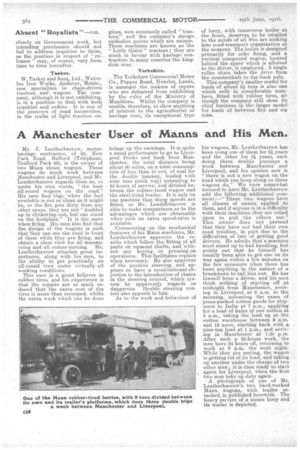A Manchester User of Nianns and His Men.
Page 16

If you've noticed an error in this article please click here to report it so we can fix it.
Mr. J. Leatherbarrow, motorhaulage contractor, of 95, New Park Road, Salford (Telephone, Trafford Park 69), is the owner of two Mann steam wagons. These wagons do much work between Manchester and Liverpool, and Mr. Leatherbarrow regards them as, to quote his own words, " the best all-round wagons on the road." His men find that, when the fuel available is not as' clean as it might be, or the fire gets dirty from any other cause, they are not "doubled up in:elinkering, out, but can stand on the footplate." It is the same when firing. His men also find that the design of the wagons is such that They can see the road in front of them while they are firing, and obtain a clear view for all Manoeuvring and all corner-turning. Mr. Leatherbarrow attaches great importance, along with his men, to the ability to get practically an all-round • view under virtually all working conditions.
This user is a great believer in rubber tires, and his, experience is that the repairs are to Much reduced that the extra cost of, the tires is more than recouped, whilst the extra work which can be done brings up the earnings. It is quite a usual performance to go to Liverpool Docks and back from Manchester, the total distance being about 80 miles, on a total consumpthin of less than 10 cwt. of coal for the double journey, loaded with nine tons (each way) extending to 22 hours of service, and divided between the rubber-tired wagon and the steel-tired trailer. It is only on one machine that threg speeds are fitted, so Mr. Leatherbarrow is able to make comparisons as to the advantages which are obtainable when such an extra speed-ratio is available.
Commenting on the mechanical features of his Mann machines, Mr. Leatherbarrow approves the results which follow the fitting of all parts on squared ghafts, and 'without any keying or pressing-on operations. This facilitates repairs when necessary. He also approves of the positive steering, and appears to have a constitutional objection to the introduction of chains in the steering control, which system he apparently regards as dangerous. Double steering control also appeals to him.
As to the work and behaviour of
his wagons, Mr. Leatherbarrow has been using one of them for 2i years and the other for 3i years, each doing three double journeys a week between Manchester and Liverpool, and his opinion now is "there is not a new wagon on the road which can keep along as these wagons do." We were somewhat amused to have Mr. Leatherbarrow add the following additional comment :—" These two wagons have all classes of names applied to them, and if anyone is in a difficulty -with their machines they are relied upon to pull the others out." This owner' does not pretend that they have not had their own road troubles, in part due to the difficulties of late of getting good drivers. He admits that a machine must stand up' to bad handling, but points out that -he himself has usually been able.to get one on its way again within a few minutes on the few occasions when there has been anything in the nature of a breakdown to call him out. He has himself been a driver, and his men think nothing of starting off at midnight from Manchester, arriving in Liverpool at 6 a.m. in the morning, unloading the cases of press-packed cotton goods for shipment to India at 7 a.m., applying for a load of bales of raw cotton at 8 a,n3., taking the load up at the cotton warehouse between 9 a.m. and 12 noon, 'starting back with a. nine-ton load at 1 p.m., and arriving in Manchester at 7.a0 p.m. After such a 22-hours work, the men have 24 hours off, returning to work ' at 8 p.m. the next night While they are resting, the wagon is getting rid of its load, and taking up another under the charge of two other men ; it is then ready to start again for Liverpool, when the first two men take up duty again. A photograph of one of Mr. Leatherbarrow 's two hard-worked Mann wagons, with trailer attached, is published herewith. The heavy setvice of a steam lorry and its trailer is depicted.






























